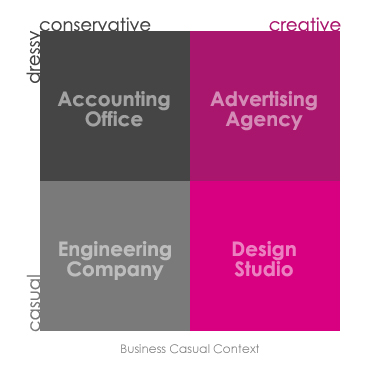“Business Casual” for women is tricky to define because it can be interpreted in so many different ways. The dress code is dressier than Smart Casual, but not quite as dressy as Business Formal. So no denim, but no suits either. This leaves a multitude of possibilities!
Your personal preferences will obviously play a big role in defining the right business casual for you, but in this post I’m going to focus on the all important context: The nature of your work and the culture of your work environment. I see two main dimensions:
- Conservative versus Creative: Work environments like an accounting office demand a modern classic and traditional style of business casual dress, and therefore lean towards the conservative side of this continuum. In a design studio, on the other hand, trendy, and even eclectic or edgy dress is encouraged and completely business appropriate as long as the outfits are modest, polished and professional.
- Casual versus Dressy: Some industries are dressy, while others are more casual. For example, the IT industry will interpret business casual closer to the casual side of this continuum, whereas financial services will interpret it more formally. The same is true in the more creative environments — some will be more dressy than others.
Here is a visual representation of this model:

Needless to say, these are generalizations. I’m sure there are law firms where the attorneys dress in creative ways. Or computer software companies where people dress more formally. Also, based on your preferences you can push things along a continuum. For example, you might prefer to err on the dressy side of business casual just because you enjoy dressing that way. And it needn’t be static over time. You might be able to move along each continuum depending on the agenda of the work day.
The important points are that each of these dimensions is a continuum, and any particular work environment is going to fall somewhere in the four quadrants.
Over the next few months I’m going to dedicate some time on YLF to business casual. I plan to tackle the diversity of different work environments by using this simple four quadrant model. What do you think of the model? Where do you think your work environment would fit best? What about other companies and industries?









